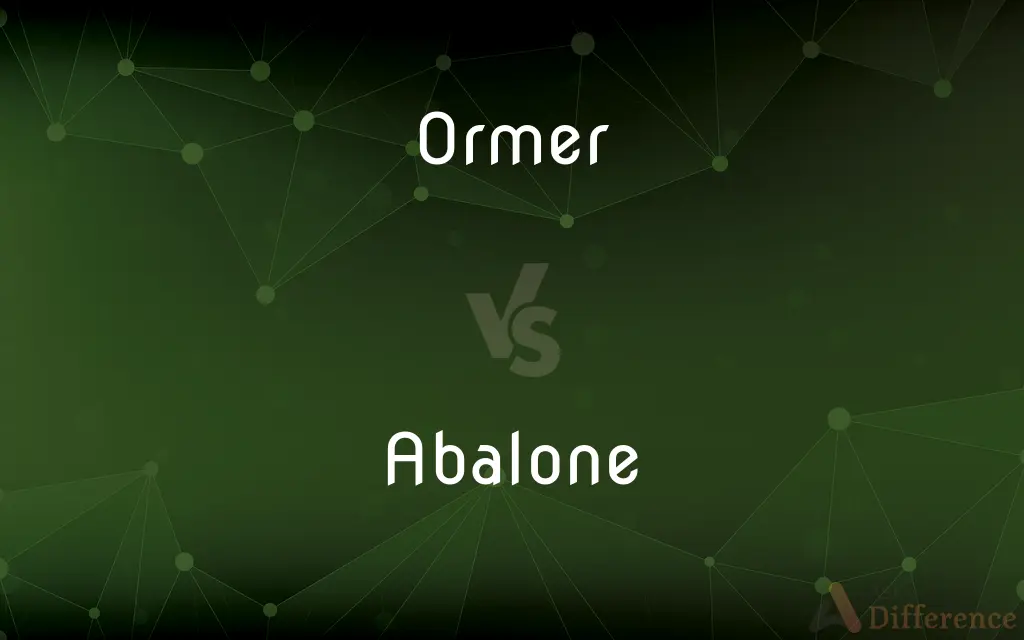Ormer vs. Abalone — What's the Difference?
By Maham Liaqat & Urooj Arif — Updated on May 6, 2024
Ormers are a type of marine snail found in the English Channel, prized for their flavor, whereas abalones are similar but more widely distributed globally, known for their iridescent shells.

Difference Between Ormer and Abalone
Table of Contents
ADVERTISEMENT
Key Differences
Ormers, also known as sea ears, belong to the Haliotidae family and are predominantly found around the Channel Islands. These gastropods are considered a delicacy and are subject to strict fishing regulations. On the other hand, abalones are found in various oceans worldwide, from the coasts of South Africa to Japan and the West Coast of the United States. They too are highly valued both for their meat and decorative shells but face less restrictive harvest laws in some regions.
Ormers have a more elongated, ear-like shape that adapts well to their rocky coastal habitats. They often remain hidden beneath seaweed or in crevices to avoid predators. In contrast, abalones have a more rounded and flattened shape, which helps them cling tightly to rocks and withstand strong water currents. Their different shapes reflect their adaptations to slightly different ecological niches.
The harvesting season for ormers is particularly limited, with fishing allowed only on specific days to prevent overexploitation and ensure sustainability. While abalones are also overfished in some areas, leading to various conservation efforts, their harvesting regulations can vary significantly by region, allowing for a more continuous collection throughout the year.
Culinary traditions surrounding ormers are deeply embedded in the cultures of the Channel Islands, where they are often prepared in stews or eaten raw. Whereas, abalone is a key ingredient in various Asian cuisines, particularly in China and Japan, where it is considered a luxury item and served on special occasions.
The shells of both ormers and abalones are highly prized, but abalone shells are particularly sought after for their iridescence, which is used in jewelry and as decorative inlays. Ormer shells, while also beautiful, are generally less colorful but have a unique charm that is appreciated in local crafts.
ADVERTISEMENT
Comparison Chart
Distribution
English Channel
Global, coastal regions
Shape
Elongated, ear-like
Rounded, flattened
Harvest Regulations
Highly restrictive
Variable by region
Culinary Use
Stews, raw
Luxury dishes, raw
Shell Appearance
Less colorful
Highly iridescent
Compare with Definitions
Ormer
A marine gastropod mollusk found around the Channel Islands, known for its edible qualities.
The chef prepared a traditional stew featuring freshly caught ormers.
Abalone
A type of marine snail with a wide global distribution, valued for its meat and shell.
Abalones are often overfished due to high demand in international markets.
Ormer
Known locally as sea ears due to their shape.
Ormers, often hidden under rocks, are challenging to spot.
Abalone
Harvesting regulations vary, affecting availability and price.
Recent changes in abalone fishing laws have impacted prices.
Ormer
Their shells, though less iridescent, are valued in local crafts.
Local artisans use ormer shells to create unique jewelry pieces.
Abalone
Features a rounded, flattened shell that helps it adhere to surfaces.
The diver carefully pried the abalone from the rock.
Ormer
Subject to strict seasonal fishing regulations to protect populations.
He marked his calendar for the upcoming ormer gathering season.
Abalone
The shell is highly iridescent, making it popular for decorative uses.
The iridescence of abalone shells makes them ideal for inlays in luxury items.
Ormer
Considered a delicacy in local Channel Island cuisine.
Ormer stew is a celebrated dish during the local festival.
Abalone
Integral to luxury Asian cuisines, often served on special occasions.
Abalone sashimi is a prized dish at the banquet.
Ormer
A European abalone (Haliotis tuberculata) found chiefly in the Channel Islands.
Abalone
Abalone ( (listen) or ; via Spanish abulón, from Rumsen aulón) is a common name for any of a group of small to very large marine gastropod molluscs in the family Haliotidae.Other common names are ear shells, sea ears, and, rarely, muttonfish or muttonshells in parts of Australia, ormer in the UK, perlemoen in South Africa, and the Maori name for three species in New Zealand is pāua.Abalone are marine snails. Their taxonomy puts them in the family Haliotidae, which contains only one genus, Haliotis, which once contained six subgenera.
Ormer
An abalone or sea-ear, particularly Haliotis tuberculata, common in the Channel Islands.
Abalone
Any of various large edible marine gastropods of the genus Haliotis, having an ear-shaped shell with a row of holes along the outer edge. The colorful pearly interior of the shell is often used for making jewelry or other ornaments. Also called ear shell.
Ormer
An abalone.
Abalone
An edible univalve mollusc of the genus Haliotis, having a shell lined with mother-of-pearl.
Ormer
An abalone found near the Channel Islands
Abalone
The meat of the aforementioned mollusc.
Abalone
A univalve mollusk of the genus Haliotis. The shell is lined with mother-of-pearl, and used for ornamental purposes; the sea-ear. Several large species are found on the coast of California, clinging closely to the rocks.
Abalone
Any of various large edible marine gastropods of the genus Haliotis having an ear-shaped shell with pearly interior
Common Curiosities
What makes ormer harvesting unique?
Ormer harvesting is tightly regulated with specific seasonal windows to ensure sustainability.
Where can abalones be found?
Abalones are found in various coastal regions around the world, including Asia, America, and Africa.
What are the conservation concerns associated with abalones?
Overfishing and illegal poaching are major concerns for abalone populations globally.
Can ormers be found outside the English Channel?
Ormers are mainly found in the English Channel and are quite rare outside this area.
How are abalones used in cuisine?
Abalones are a luxury food item in Asian cuisines, often served raw or gently cooked.
Why are abalone shells so valued?
Their iridescent nature makes abalone shells highly sought after for decorative and jewelry purposes.
What is the best way to cook ormers?
Ormers are traditionally cooked in stews or served raw, seasoned with local herbs.
What are some traditional dishes featuring abalone?
Abalone is featured in dishes such as sashimi, steamed abalone, and abalone porridge in various cuisines.
What are ormers?
Ormers are marine gastropods native to the English Channel, valued for their edible meat.
Are ormer shells used commercially?
While less common than abalone shells, ormer shells are used in local crafts in their native regions.
How does abalone fishing impact the environment?
Unsustainable fishing practices can lead to habitat destruction and decline in abalone populations.
Is it legal to gather ormers anytime?
No, ormer gathering is only allowed on specific days to protect their populations from overharvesting.
How do the shapes of ormers and abalones differ?
Ormers have an elongated shape, whereas abalones are more rounded and flattened.
What regulations affect abalone fishing?
Abalone fishing is regulated by local and international laws, which can vary widely between regions.
Why are ormers considered a delicacy?
Due to their unique flavor and rarity, ormers are highly prized in Channel Island cuisine.
Share Your Discovery

Previous Comparison
Booklet vs. Pamphlet
Next Comparison
Lustre vs. MatteAuthor Spotlight
Written by
Maham LiaqatCo-written by
Urooj ArifUrooj is a skilled content writer at Ask Difference, known for her exceptional ability to simplify complex topics into engaging and informative content. With a passion for research and a flair for clear, concise writing, she consistently delivers articles that resonate with our diverse audience.
















































